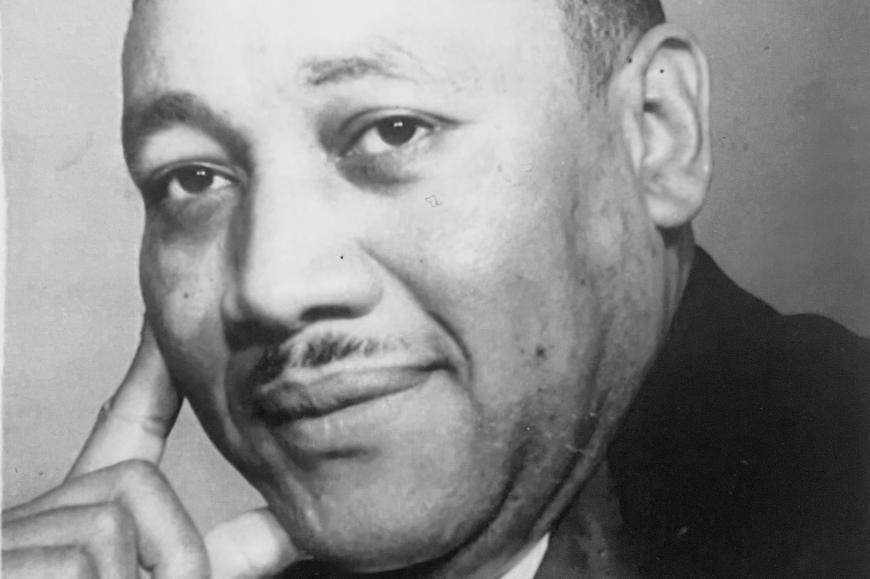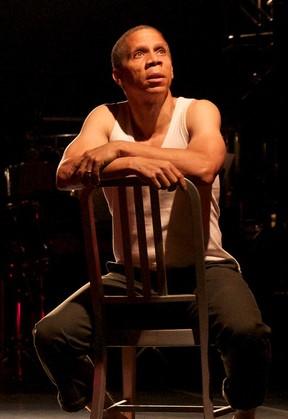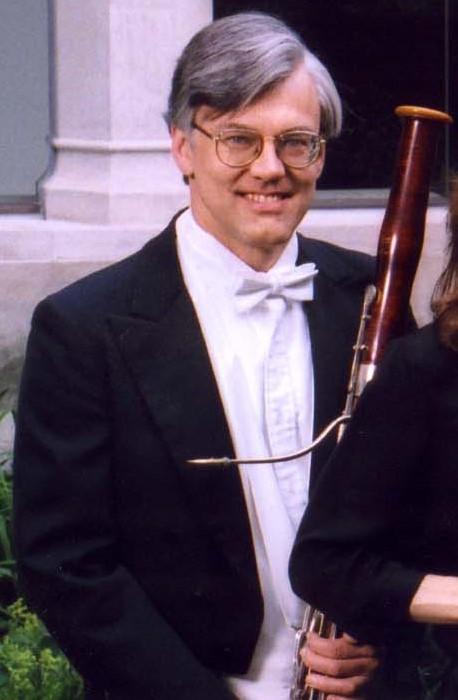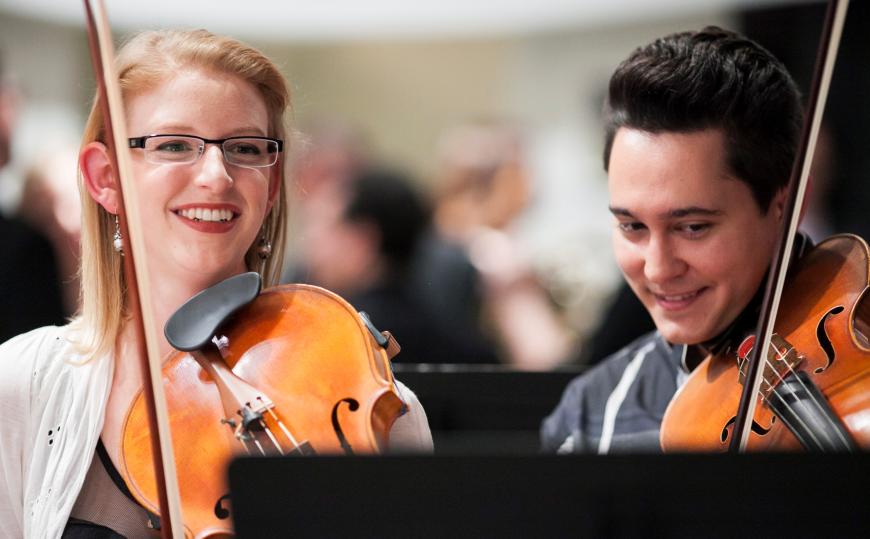
For nearly 70 years, the meticulous handwritten manuscripts of four symphonies and other orchestral works lay silent and undisturbed in a large trunk in Eugene Perry’s Pennsylvania home. The music, composed by the grandfather Perry was vastly influenced by but never knew — composer, professor, and choral director Herbert Franklin Mells — had never been published, copyrighted, or performed. Each 30-by-28-inch page represented both a classical music tragedy and decades of racism in real time. And then one afternoon, Perry, a bass-baritone who, at age 68, recently retired from the stage after 35 years as a professional musician, received a message.
“It was Jim Whipple [R. James Whipple, artist lecturer in music theory at Carnegie Mellon University],” Perry said, recalling the email he received two years ago. “He and I had worked together when I introduced him to three songs of my grandfather’s, and he transcribed them for a quintet/wind ensemble he directs in Pittsburgh. I invited him over to show him the music manuscripts in the trunk given to me by my aunt. We looked through them, and he said he wanted to study one of the symphonies. I said, ‘Go ahead, take it.’ Later, I’m not sure how long, he called and said, ‘You’re going to get a phone call from someone who might be interested in one of your grandfather’s symphonies.’”
Soon, Perry was on a Zoom call with three members of the San Francisco-based chamber orchestra One Found Sound. Co-founded in 2013 by musicians Georgeanne Banker, Sarah Bonomo, Scott Padden, Emily Kriner, and Sasha Launer, OFS is a democratic, collaborative, conductorless ensemble that seeks in all its work to operate at the forefront of equitable and barrier-free music.

“I remember it was [clarinetist] Sarah, [flutist] Sasha, and [filmmaker] Max Savage, and it was great,” Perry said. “I was excited. The music — to be perfectly honest — my aunt gave it to me because she knew she was dying and was thinking I would do something with it. When I got it, I wasn’t sure what to do. A lot of it had never been copyrighted or published. The people he worked for said there was no market for his symphony pieces because he was a Black man. They said there was a market for his choir pieces and spirituals but not for the big overtures and quartets and symphonies. So I put it aside because I was building my career and still performing. Then when there was this interest from One Found Sound, I started to wake up. I thought it was wonderful.”
Thus, the groundwork was laid for a serious undertaking. Over the next five years, OFS’s Herbert Franklin Mells Project will include world premieres and recordings of four of the orchestral works Mells composed between 1938 and 1945, along with the production of first-edition scores and orchestral parts, transcribed and published externally by Whipple.
One of the project’s broader goals is to serve as a model and resource for musicians and organizations seeking to bring equity, inclusion, and diversity to classical music. OFS hopes to launch a deep investigation into the historical intersection of structural racism and classical music in the United States and offer inspiration and encouragement for the music industry to amplify the long-silenced voices of composers from history, as well as support living composers and up-and-coming musicians who are also people of color.
Born in 1908, Mells served as the music department chair at Langston University, the Hampton Institute, and later Tennessee State University, where he taught until his untimely death from spinal meningitis in 1953 at age 44. Although his orchestral works were never published or performed, he wrote a tremendous catalog of instrumental and vocal music. Among the latter, the most remembered, according to notes from OFS, are “Burden’d Chile (A Spiritual Lament),” “I’ve Got Religion,” and “A Christmas Lullaby: In the Style of a Negro Lullaby.”
Asked about the strengths and characteristics of Mells’s Symphony No. 1 in D Minor (1938), Whipple writes that the work is surprisingly post-Romantic and, in his estimation, falls into the lineage of Antonín Dvořák’s “New World” Symphony (1893) and Florence Price’s Symphony No. 1 (1932). He said:
Although 21 years younger than Price, Mells still grew up in an environment where Romanticism rather than modernism would have been the prevailing aesthetic. The symphony alternates between weighty passages in the prevailing minor key and lighter, lyrical major-key ideas that are downright cheerful. The work is cast in the traditional four-movement mold of modified sonata form, slow movement, minuet and trio, and a finale with slow introduction. While the language leans heavily on its 19th-century heritage, Mells has a genuine sense of harmonic drama. The brass chords closing the slow movement are just one fine example of that. His orchestration is quite transparent, and the textures are never thick or muddy. The balances are carefully calculated, and the listener is not likely to lose his train of thought. With such deep roots in Romanticism, the ‘American-ness’ of this symphony is subtle, but it’s there — in the occasional modal tinges and pentatonic melodic patterns that appear.”

Mells sustained a two-fold blow to his career and development as a composer because his larger works were never performed or even given complete readings, according to Whipple. His reputation was limited, and his artistic development restricted. “His choral works, original songs, and spiritual settings were all fairly short, just a few pages as is typical for such works. That could falsely suggest he was only a miniaturist, since all of his large-scale works were ignored,” said Whipple. “The artistic cost is that most composers — even the most famous European composers in the generations before — would typically revise symphonic works after hearing them to fix problems of form or balance. Mells never got this opportunity, to either revise his first works or to incorporate that feedback in future works, since he died so young.”
So Mells’s contributions to symphonic music were lost until now. Whipple said a “long, long essay could be written” on the topic of the impact of segregation and racism on not only this one Black American composer but on all Black, non-white, and women artists’ contributions to classical music and its attending spheres of academia, culture, commerce, repertoire, and audiences. He offered an abbreviated version:
“Racism tended to repress the works of Black composers in the United States. The composer/violinist/conductor Eugène Dédé, long a resident of France despite growing up in New Orleans, made only one trip back to the United States in the 1890s and was disgusted that he wasn’t even allowed to perform in regular concert halls. After just one U.S. tour where he was relegated to churches and community sites, he returned to France where he was well regarded and held a prestigious conducting position.
“By Mells’s lifetime there had not been a lot of improvement to this situation. Despite earning his master’s degree and Ph.D. at two prestigious music schools, Indiana University and the University of Iowa, his primary academic position was at Tennessee State University, founded in 1912 and the only HBCU [historically Black college and university] in the state. He was the first chair of the developing music program there, but that did not seem to produce the networking with other institutions to open performance opportunities for his works. Mells’s spiritual settings, and some of his original vocal works, were published by his friend W.C. Handy because there was sales potential, but that interest did not extend to his instrumental works.”

Whipple’s words are like the proverbial fire that ignites OFS flutist Launer. “It goes without saying what a tragedy it is, all the music that was lost,” she said. “This is just one composer whose work was refused publishing because of his race. You think about all of the composers, artists, and all of the people with all of that talent that were denied. It was a tragedy for them, but also for our society as a whole, to have lost all of that work. There’s no way to measure it or know the works not written or published or never written at all. Our step [with this project] is only one step, and society must take so many steps. … We asked ourselves what we can do as musicians and what we can do to course-correct. We can bring his work to life. We’re never going to make it right, but we can make it a change for the future.”
OFS’s “step” leads back to Carnegie Mellon, where Launer once studied with Whipple. A member of OFS’s admin team, she sometimes contacted him when the group was issuing its call for scores for its annual Emerging Composer Award. The initiative is open to composers 30 years of age or younger who identify as Black, Indigenous, Latino, Asian, or Pacific Islander or as a person of color. The winning compositions are performed by OFS, and the composers receive $1,000 cash prizes. “I reached out and asked him to spread the word,” Launer said. “He said he knew of some promising composers, and in the meantime, he did know of this Black composer who was significant, but his orchestral works had never been recorded or performed.”
Intrigued, Launer took the information about Mells to her colleagues and, through their usual democratic process and a town hall, met with the entire orchestra. Together, the musicians poured over a manuscript, their ears imagining a performance of the work. Immediately, a unanimous vote had everyone backing the project. Early funding came largely from the “Onesies,” an avid group of financial supporters. Continued resources will be necessary to complete the entire five-year plan; for that, in addition to regular patrons and one-time donations, the group is pursuing various grants.
Launer said having the Onesies support is “lucky,” as is the opportunity provided by the Mells family. “We’re so lucky to have these manuscripts. We just have to do this. We just have to have these works become part of the canon. If there are works by other composers we can bring to life, we have to provide that.” She said the obligation is not simply intrinsic to OFS’s commitment to diversity and equity but is one she believes is personal. “Understand that this is not how the world should be, but because I’m white, I have privilege. I have a bigger platform. The onus is on me to do what I can, however I can do it. If I have a platform to increase racial equity and displace historic, systemic white privilege, I’m going to use it.”

The instrumentation for Mells’s Symphony No. 1, which has its world premiere March 4 on a program that also includes Beethoven’s Coriolan Overture, Op. 62, and Quinn Mason’s Reflection on a Memorial, is notably large for OFS, according to Launer. It’s scored for double woodwinds, two horns, two trumpets, two trombones, tuba, timpani, percussion, and a full string section consisting of ten violins, four violas, four cellos, and two basses.
“It feels like he is playing with tone color and timbres,” Launer said. “He has melodies that pass from instrument to instrument. He actually writes arrows in the manuscript. There’s a choral hymn that comes together only at the end, but throughout the whole rest of the movement, it passes from instrument to instrument. When it comes together, there is a climax. Before that, you hear the beauty as he highlights the different instruments and their qualities.”
And on her instrument, the third movement provides Launer the greatest reward. “It’s a scherzo that highlights the flute, with a melody that passes between the violins and solo flute. It’s fun and, for me, joyous to play.”
The greatest challenge is in transferring the lines and musical phrases seamlessly between instruments whose colors and timbres strongly contrast. “If it had been written for instruments that match so you can change seamlessly, that would have been easier,” Launer explained. “But when you do this well, it’s so rewarding. It’s something that in rehearsal we have had to dig into and make sure we do it well. If you don’t, it sounds choppy. The contrasts are a cool effect, but it’s not easy to achieve.”

Because the five-year project includes three other works OFS has not yet plunged into, Launer sent excerpts of quotes from Mells, along with general overviews of the pieces found in the trunk, taken from literature the group has collected.
Symphony No. 2 in B Minor was written in 1944 in partial fulfillment of Mells’s doctoral degree from the University of Iowa. The work’s thematic material draws upon the composer’s vocal composition “Burden’d Chile.” This spiritual, composed by Mells in 1938, contemplates the relationship between lived hardships and the promise of heavenly pleasures.
Symphonic Poem of the Americas was composed in 1945. Through this work, Mells considers the ethos of Franklin Delano Roosevelt’s Good Neighbor Policy and domestic practices of racial inequity.
News Flashes of Late ’44 was composed in 1944. This symphonic poem, scored for a large orchestra including auxiliary wind instruments, decries the horrors of the Battle of the Bulge and muses on Mells’s complex personal feelings about war and peace.
For Perry, the “awakening” he experienced after being contacted by OFS has caused him to reflect on his relationship with his grandfather.
Basically, we were raised on the Tennessee State University campus, which at that time was the Tennessee Agricultural & Industrial State College. My grandfather was head of the music department there when he died, and we went to live there with my grandmother. My mother was a classical pianist and played as an accompanist for the students and the choir. We had classical music around us all the time. We lived in the apartments on the second floor of the music building, above where the classes were held. So we got our music from our home.
There were six of us kids. I remember mainly the albums we had with the recordings of symphonies and my mother playing piano all the time. We had a recording of Eileen Farrell, who did all the Puccini arias. I remember Beethoven, not a lot of Mozart, but a lot of Handel. I was maybe 5 years old when, in second grade, we started picking up instruments from school. I started with cello. Schools were different then, and music was necessary. We joined the orchestra. My older sister played viola. Then my twin brother and I joined. We did that for one year, then my brother and I decided to join the brass band.”
Perry said he had few problems as a Black man entering the classical music field but also learned early on to ignore or rise above the microaggressions and overt demonstrations of racism he encountered. “On tours, people would see you, a Black person, and some sponsors were weird. There was a feeling that you weren’t accepted. For example, one man who donated money had a dinner, and he had me sit next to him. When I would talk, his expression was as if what I said wasn’t important. I ignored it because I was above that. He had the problem, and I didn’t. I was an artist. I sang. It just didn’t bother me. Another time, the people who worked at the company were telling racial jokes. Another time, the hosts invited us to dinner after a show in which I had makeup and a wig and was doing Barber of Seville. Onstage, you couldn’t tell if I was Black or white or Italian. Afterward at the party, someone wanted to know all about me, as if I was unusual. Those things were petty. Professionally, I knew I had a voice, and so it never stopped me from having my career.”
Even so, Perry recognizes that his grandfather had a far different experience and that the significance of Mells’s orchestral work finally entering the canon and the power of his life story receiving public attention cannot be overstated. “My grandfather was a powerful man. He was not your usual person. If you saw the amount of music he wrote, it would blow your mind. Especially because he died at age 44. He had four kids. When did he have time to have so much presence with his family? The piano music underneath the vocal is powerful. The First Symphony is masterful. He conducted the final movement in 1938 in front of Indiana University’s all-white orchestra. He was a Black man, 30 years old. What happened?
“I’m thinking about him and his power and dignity. That’s in the music, so maybe something will come out of this. One Found Sound is getting an amazing opportunity. His music — the color, style, and tone — will differentiate him. The project will show the development of his work while he was a chairman of three universities, traveling, touring during the summers. I’m curious myself to see what will be revealed.”




